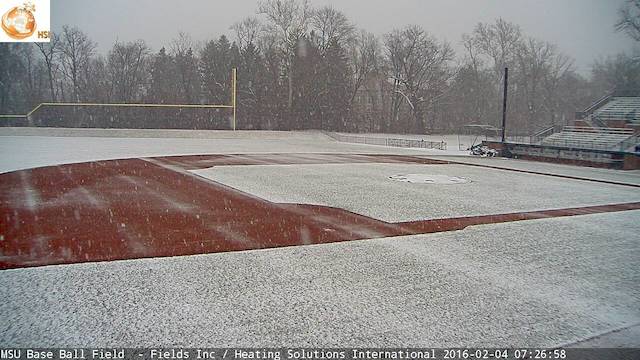By Amy J. Fouty, CSFM
In the spring of 2016 the Michigan State softball and baseball programs had a new option for spring practices in February—taking the field, rather than the normal northern climate indoor hitting/pitching facility or field houses. Having the ability to go outside, take ground balls and see the ball come off the mound or out of the pitching circle was unheard of in February here in East Lansing. On January 29, 2016, the first day of spring practice for baseball, I was standing with the coaches watching batting practice, seeing just that.
How did we get to this point?
In 2014, it all began with a conversation standing on the field talking about the future of natural grass playing surfaces. Lots of “wouldn’t it be cool if . . . or wouldn’t it be neat if we could . . . ” and then one day I was fortunate enough to have that conversation with a couple people who shared the same vision and the ability to make that vision a reality.
For many people who know me, they know this: I am very conservative when it comes to managing and maintaining grass. We perform tried and true practices and use products that have demonstrated that same consistency over the years. However, as a Land Grant University and agriculturally grounded institution, we do explore technology, and from time to time we push the realm of what is considered normal. This was one of those times and is what keeps me excited about being a turf grass professional at MSU.
As in many situations, we had more questions than answers to start the process of researching the idea and feasibility of the electric field heating system in our climate. We came across an option that is readily used in Europe: electric ribbons as the heating source. Electric technology has come a long way from the heat coils of the 70’s. A series of metal ribbons, placed 9 inches apart, delivers all the heat necessary to keep the field playable. We set it up so that all the controls are remotely accessible and the video feed option allows me and our manufacturer the opportunity to see what we are seeing and experiencing via a secure link. We did some research on the electrical capacity and found that with the electrical install prepped for future field lighting we had enough electricity to handle the two systems.
So there the process began; we designed and estimated the project, fundraised enough to cover the cost of the construction, and addressed all the concerns and issues we could within the University and the Athletic Department. I remember the cold drizzly spring day in 2015, when I sat at my desk with the purchase order in my hand, smiling, a little amazed we were finally here and doing it.
Getting it done
The end of July came quickly; we were dismantling and prepping our [Sports Turf Managers Association 2014 College Baseball Field of the Year] baseball field, and saying a few prayers that all would transpire in the next few months, as we had diligently planned. As with all projects, it had a few challenges, especially since we were installing the first electric ribbon field heating system in North America. Things electrically work a little different in Europe than the US but we persevered and worked through the issues as the team completed fall practices. January 11, 2016, arrived and we turned the heat on for the first time. We worked through a few bugs with the manufacturer’s assistance and 10 days later had the field thawed out and playable.
So you will probably ask, so were you planning to grow grass? The answer is no, we do not use the system to grow grass at that time of year; we use the system to thaw and keep the ground thawed so that the surface is safe and playable for student-athletes to practice. I will admit Mother Nature reminded us that she was in charge of the weather a few times through the process. We learned what was feasible and what was not. By early March we finally reached a point where we saw some consistency in the weather conditions. During this time we were able to use the system to keep quality playable conditions during freezing and thawing periods in the weather, which often in the past would have caused unplayable conditions.
Overall I believe it was a successful experiment and one that will continue to provide us with opportunity to play and practice earlier so our programs can be more competitive earlier in the season. From the field operations staff perspective we learned a great deal monitoring weather, soil temperatures, and moisture content. As technology advances so does the role and need for understanding of sports field managers. Professional development and continued education is a must for today’s athletic field manager to be successful given the rapidly changing technology. We must evolve with the times to be a valued professional in our organizations.
If you have questions please feel free to e-mail me at fouty@ath.msu.edu.
Amy Fouty, CSFM, is athletic turf manager for Michigan State Athletics.


